Deck 14: Oscillations
Question
Question
Question
Question
Question
Question
Question
Question
Question
Question
Question
Question
Question
Question
Question
Question
Question
Question
Question
Question
Question
Question
Question
Question
Question
Question
Question
Question
Question
Question
Question
Question
Question
Question
Question
Question
Question
Question
Question
Question
Question
Question
Question
Question
Question
Question
Question
Question
Question
Question
Question
Question
Question
Question
Question
Question
Question
Question
Question
Question
Question
Question
Question
Question
Question
Question
Question
Question
Question
Question
Question
Question
Question
Question
Question
Question
Question
Question
Question
Question

Unlock Deck
Sign up to unlock the cards in this deck!
Unlock Deck
Unlock Deck
1/105
Play
Full screen (f)
Deck 14: Oscillations
1
The figure shows a graph of the position x as a function of time t for a system undergoing simple harmonic motion. Which one of the following graphs represents the acceleration of this system as a function of time? 
A.

B.
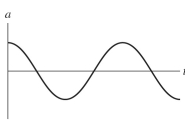
C.

D.
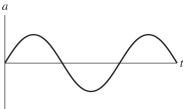
A)graph a
B)graph b
C)graph c
D)graph d

A.

B.

C.

D.

A)graph a
B)graph b
C)graph c
D)graph d
graph a
2
An object is attached to a vertical spring and bobs up and down between points A and B. Where is the object located when its elastic potential energy is a maximum?
A)at either A or B
B)midway between A and B
C)one-third of the way between A and B
D)one-fourth of the way between A and B
E)at none of the above points
A)at either A or B
B)midway between A and B
C)one-third of the way between A and B
D)one-fourth of the way between A and B
E)at none of the above points
A
3
Two simple pendulums, A and B, are each 3.0 m long, and the period of pendulum A is T. Pendulum A is twice as heavy as pendulum B. What is the period of pendulum B?
A)T/
B)T
C)T
D)2T
E)T/2
A)T/
B)T
C)T
D)2T
E)T/2
T
4
In simple harmonic motion, when is the speed the greatest? (There could be more than one correct choice.)
A)when the magnitude of the acceleration is a maximum
B)when the displacement is a maximum
C)when the magnitude of the acceleration is a minimum
D)when the potential energy is a maximum
E)when the potential energy is a zero
A)when the magnitude of the acceleration is a maximum
B)when the displacement is a maximum
C)when the magnitude of the acceleration is a minimum
D)when the potential energy is a maximum
E)when the potential energy is a zero

Unlock Deck
Unlock for access to all 105 flashcards in this deck.
Unlock Deck
k this deck
5
A mass on a spring undergoes SHM. When the mass passes through the equilibrium position, which of the following statements about it are true? (There could be more than one correct choice.)
A)Its acceleration is zero.
B)Its speed is zero.
C)Its elastic potential energy is zero.
D)Its kinetic energy is a maximum.
E)Its total mechanical energy is zero.
A)Its acceleration is zero.
B)Its speed is zero.
C)Its elastic potential energy is zero.
D)Its kinetic energy is a maximum.
E)Its total mechanical energy is zero.

Unlock Deck
Unlock for access to all 105 flashcards in this deck.
Unlock Deck
k this deck
6
Grandfather clocks are designed so they can be adjusted by moving the weight at the bottom of the pendulum up or down. Suppose you have a grandfather clock at home that runs slow. Which of the following adjustments of the weight would make it more accurate? (There could be more than one correct choice.)
A)Raise the weight.
B)Lower the weight.
C)Add more mass to the weight.
D)Remove some mass from the weight.
E)Increase the amplitude of swing by a small amount.
A)Raise the weight.
B)Lower the weight.
C)Add more mass to the weight.
D)Remove some mass from the weight.
E)Increase the amplitude of swing by a small amount.

Unlock Deck
Unlock for access to all 105 flashcards in this deck.
Unlock Deck
k this deck
7
An object is attached to a vertical spring and bobs up and down between points A and B. Where is the object located when its kinetic energy is a maximum?
A)at either A or B
B)midway between A and B
C)one-third of the way between A and B
D)one-fourth of the way between A and B
E)at none of the above points
A)at either A or B
B)midway between A and B
C)one-third of the way between A and B
D)one-fourth of the way between A and B
E)at none of the above points

Unlock Deck
Unlock for access to all 105 flashcards in this deck.
Unlock Deck
k this deck
8
If we double the frequency of a system undergoing simple harmonic motion, which of the following statements about that system are true? (There could be more than one correct choice.)
A)The period is doubled.
B)The angular frequency is doubled.
C)The amplitude is doubled.
D)The period is reduced to one-half of what it was.
E)The angular frequency is reduced to one-half of what it was.
A)The period is doubled.
B)The angular frequency is doubled.
C)The amplitude is doubled.
D)The period is reduced to one-half of what it was.
E)The angular frequency is reduced to one-half of what it was.

Unlock Deck
Unlock for access to all 105 flashcards in this deck.
Unlock Deck
k this deck
9
A ball swinging at the end of a massless string, as shown in the figure, undergoes simple harmonic motion. At what point (or points)is the magnitude of the instantaneous acceleration of the ball the greatest? 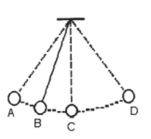
A)C
B)A and D
C)A and C
D)A and B
E)B

A)C
B)A and D
C)A and C
D)A and B
E)B

Unlock Deck
Unlock for access to all 105 flashcards in this deck.
Unlock Deck
k this deck
10
An object is attached to a vertical spring and bobs up and down between points A and B. Where is the object located when its kinetic energy is a minimum?
A)at either A or B
B)midway between A and B
C)one-third of the way between A and B
D)one-fourth of the way between A and B
E)at none of the above points
A)at either A or B
B)midway between A and B
C)one-third of the way between A and B
D)one-fourth of the way between A and B
E)at none of the above points

Unlock Deck
Unlock for access to all 105 flashcards in this deck.
Unlock Deck
k this deck
11
A mass on a spring undergoes SHM. When the mass is at its maximum distance from the equilibrium position, which of the following statements about it are true? (There could be more than one correct choice.)
A)Its acceleration is zero.
B)Its speed is zero.
C)Its elastic potential energy is zero.
D)Its kinetic energy is a maximum.
E)Its total mechanical energy is zero.
A)Its acceleration is zero.
B)Its speed is zero.
C)Its elastic potential energy is zero.
D)Its kinetic energy is a maximum.
E)Its total mechanical energy is zero.

Unlock Deck
Unlock for access to all 105 flashcards in this deck.
Unlock Deck
k this deck
12
A simple harmonic oscillator oscillates with frequency f when its amplitude is A. If the amplitude is now doubled to 2A, what is the new frequency?
A)2f
B)4f
C)f
D)f/2
E)f/4
A)2f
B)4f
C)f
D)f/2
E)f/4

Unlock Deck
Unlock for access to all 105 flashcards in this deck.
Unlock Deck
k this deck
13
An object attached to an ideal spring executes simple harmonic motion. If you want to double its total energy, you could
A)double the amplitude of vibration.
B)double the force constant (spring constant)of the spring.
C)double both the amplitude and force constant (spring constant).
D)double the mass.
E)double both the mass and amplitude of vibration.
A)double the amplitude of vibration.
B)double the force constant (spring constant)of the spring.
C)double both the amplitude and force constant (spring constant).
D)double the mass.
E)double both the mass and amplitude of vibration.

Unlock Deck
Unlock for access to all 105 flashcards in this deck.
Unlock Deck
k this deck
14
An object that hangs from the ceiling of a stationary elevator by an ideal spring oscillates with a period T. If the elevator accelerates upward with acceleration 2g, what will be the period of oscillation of the object?
A)4T
B)2T
C)T
D)T/2
E)T/4
A)4T
B)2T
C)T
D)T/2
E)T/4

Unlock Deck
Unlock for access to all 105 flashcards in this deck.
Unlock Deck
k this deck
15
In simple harmonic motion, when is the magnitude of the acceleration the greatest? (There could be more than one correct choice.)
A)when the speed is a maximum
B)when the displacement is a zero
C)when the magnitude of the displacement is a maximum
D)when the potential energy is a maximum
E)when the kinetic energy is a minimum
A)when the speed is a maximum
B)when the displacement is a zero
C)when the magnitude of the displacement is a maximum
D)when the potential energy is a maximum
E)when the kinetic energy is a minimum

Unlock Deck
Unlock for access to all 105 flashcards in this deck.
Unlock Deck
k this deck
16
An object is attached to a vertical spring and bobs up and down between points A and B. Where is the object located when its elastic potential energy is a minimum?
A)at either A or B
B)midway between A and B
C)one-third of the way between A and B
D)one-fourth of the way between A and B
E)at none of the above points
A)at either A or B
B)midway between A and B
C)one-third of the way between A and B
D)one-fourth of the way between A and B
E)at none of the above points

Unlock Deck
Unlock for access to all 105 flashcards in this deck.
Unlock Deck
k this deck
17
The figure shows a graph of the velocity v as a function of time t for a system undergoing simple harmonic motion. Which one of the following graphs represents the acceleration of this system as a function of time? 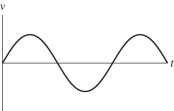
A.
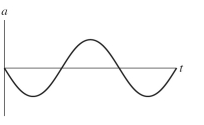
B.
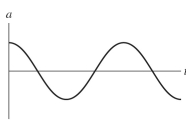
C.
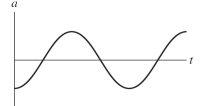
D.

A)graph a
B)graph b
C)graph c
D)graph d

A.

B.

C.

D.

A)graph a
B)graph b
C)graph c
D)graph d

Unlock Deck
Unlock for access to all 105 flashcards in this deck.
Unlock Deck
k this deck
18
The total mechanical energy of a simple harmonic oscillating system is
A)zero as it passes the equilibrium point.
B)zero when it reaches the maximum displacement.
C)a maximum when it passes through the equilibrium point.
D)a minimum when it passes through the equilibrium point.
E)a non-zero constant.
A)zero as it passes the equilibrium point.
B)zero when it reaches the maximum displacement.
C)a maximum when it passes through the equilibrium point.
D)a minimum when it passes through the equilibrium point.
E)a non-zero constant.

Unlock Deck
Unlock for access to all 105 flashcards in this deck.
Unlock Deck
k this deck
19
Identical balls oscillate with the same period T on Earth. Ball A is attached to an ideal spring and ball B swings back and forth to form a simple pendulum. These systems are now taken to the Moon, where g = 1.6 m/s2, and set into oscillation. Which of the following statements about these systems are true? (There could be more than one correct choice.)
A)Both systems will have the same period on the Moon as on Earth.
B)On the Moon, ball A will take longer to complete one cycle than ball B.
C)On the Moon, ball B will take longer to complete one cycle than ball A.
D)On the Moon, ball A will execute more vibrations each minute than ball B.
E)On the Moon, ball B will execute more vibrations each minute than ball A.
A)Both systems will have the same period on the Moon as on Earth.
B)On the Moon, ball A will take longer to complete one cycle than ball B.
C)On the Moon, ball B will take longer to complete one cycle than ball A.
D)On the Moon, ball A will execute more vibrations each minute than ball B.
E)On the Moon, ball B will execute more vibrations each minute than ball A.

Unlock Deck
Unlock for access to all 105 flashcards in this deck.
Unlock Deck
k this deck
20
The figure shows a graph of the position x as a function of time t for a system undergoing simple harmonic motion. Which one of the following graphs represents the velocity of this system as a function of time? 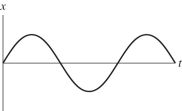
A.
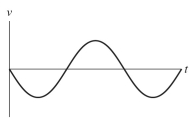
B.
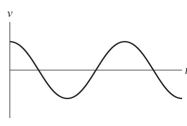
C.
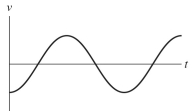
D.
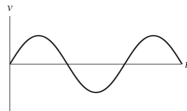
A)graph a
B)graph b
C)graph c
D)graph d

A.

B.

C.

D.

A)graph a
B)graph b
C)graph c
D)graph d

Unlock Deck
Unlock for access to all 105 flashcards in this deck.
Unlock Deck
k this deck
21
A sewing machine needle moves in simple harmonic motion with a frequency of 2.5 Hz and an amplitude of 1.27 cm.
(a)How long does it take the tip of the needle to move from the highest point to the lowest point in its travel?
(b)How long does it take the needle tip to travel a total distance of 11.43 cm?
(a)How long does it take the tip of the needle to move from the highest point to the lowest point in its travel?
(b)How long does it take the needle tip to travel a total distance of 11.43 cm?

Unlock Deck
Unlock for access to all 105 flashcards in this deck.
Unlock Deck
k this deck
22
If the frequency of a system undergoing simple harmonic motion doubles, by what factor does the maximum value of acceleration change?
A)4
B)2
C)
D)2/?
A)4
B)2
C)
D)2/?

Unlock Deck
Unlock for access to all 105 flashcards in this deck.
Unlock Deck
k this deck
23
A sewing machine needle moves up and down in simple harmonic motion with an amplitude of 1.27 cm and a frequency of 2.55 Hz. What are the (a)maximum speed and (b)maximum acceleration of the tip of the needle?

Unlock Deck
Unlock for access to all 105 flashcards in this deck.
Unlock Deck
k this deck
24
An object is undergoing simple harmonic motion of amplitude 2.3 m. If the maximum velocity of the object is 10 m/s, what is the object's angular frequency?
A)4.3 rad/s
B)4.8 rad/s
C)3.5 rad/s
D)4.0 rad/s
A)4.3 rad/s
B)4.8 rad/s
C)3.5 rad/s
D)4.0 rad/s

Unlock Deck
Unlock for access to all 105 flashcards in this deck.
Unlock Deck
k this deck
25
A simple pendulum that consists of a small ball of mass m and a massless wire of length L swings with a period T. Suppose now that the mass is rearranged so that mass of the ball was reduced but the mass of the wire was increased, with the total mass remaining m and the length being L. What is true about the new period of swing? (There could be more than one correct choice.)
A)The new period is T because the total mass m has not changed.
B)The new period is T because the length L has not changed.
C)The new period is greater than T.
D)The new period is less than T
E)The new period is T because neither L nor m have changed.
A)The new period is T because the total mass m has not changed.
B)The new period is T because the length L has not changed.
C)The new period is greater than T.
D)The new period is less than T
E)The new period is T because neither L nor m have changed.

Unlock Deck
Unlock for access to all 105 flashcards in this deck.
Unlock Deck
k this deck
26
A simple pendulum and a mass oscillating on an ideal spring both have period T in an elevator at rest. If the elevator now accelerates downward uniformly at 2 m/s2, what is true about the periods of these two systems?
A)Both periods would remain the same.
B)Both periods would increase.
C)Both periods would decrease.
D)The period of the pendulum would increase but the period of the spring would stay the same.
E)The period of the pendulum would decrease but the period of the spring would stay the same.
A)Both periods would remain the same.
B)Both periods would increase.
C)Both periods would decrease.
D)The period of the pendulum would increase but the period of the spring would stay the same.
E)The period of the pendulum would decrease but the period of the spring would stay the same.

Unlock Deck
Unlock for access to all 105 flashcards in this deck.
Unlock Deck
k this deck
27
The quartz crystal in a digital watch has a frequency of 32.8 kHz. What is its period of oscillation?
A)30.5 µs
B)15.3 µs
C)95.8 µs
D)0.191 ms
E)9.71 µs
A)30.5 µs
B)15.3 µs
C)95.8 µs
D)0.191 ms
E)9.71 µs

Unlock Deck
Unlock for access to all 105 flashcards in this deck.
Unlock Deck
k this deck
28
A leaky faucet drips 40 times in What is the frequency of the dripping?
A)1.3 Hz
B)0.75 Hz
C)1.6 Hz
D)0.63 Hz
A)1.3 Hz
B)0.75 Hz
C)1.6 Hz
D)0.63 Hz

Unlock Deck
Unlock for access to all 105 flashcards in this deck.
Unlock Deck
k this deck
29
A simple pendulum and a mass oscillating on an ideal spring both have period T in an elevator at rest. If the elevator now moves downward at a uniform 2 m/s, what is true about the periods of these two systems?
A)Both periods would remain the same.
B)Both periods would increase.
C)Both periods would decrease.
D)The period of the pendulum would increase but the period of the spring would stay the same.
E)The period of the pendulum would decrease but the period of the spring would stay the same.
A)Both periods would remain the same.
B)Both periods would increase.
C)Both periods would decrease.
D)The period of the pendulum would increase but the period of the spring would stay the same.
E)The period of the pendulum would decrease but the period of the spring would stay the same.

Unlock Deck
Unlock for access to all 105 flashcards in this deck.
Unlock Deck
k this deck
30
If your heart is beating at 76.0 beats per minute, what is the frequency of your heart's oscillations in hertz?
A)4560 Hz
B)1450 Hz
C)3.98 Hz
D)2.54 Hz
E)1.27 Hz
A)4560 Hz
B)1450 Hz
C)3.98 Hz
D)2.54 Hz
E)1.27 Hz

Unlock Deck
Unlock for access to all 105 flashcards in this deck.
Unlock Deck
k this deck
31
If a floating log is seen to bob up and down 15 times in 1.0 min as waves pass by you, what are the frequency and period of the wave?

Unlock Deck
Unlock for access to all 105 flashcards in this deck.
Unlock Deck
k this deck
32
The position of a cart that is oscillating on a spring is given by the equation x = (12.3 cm)cos[(1.26 s-1)t]. When t = 0.805 s, what are the (a)velocity and (b)acceleration of the cart?

Unlock Deck
Unlock for access to all 105 flashcards in this deck.
Unlock Deck
k this deck
33
Grandfather clocks are designed so they can be adjusted by moving the weight at the bottom of the pendulum up or down. Suppose you have a grandfather clock at home that runs fast. Which of the following adjustments of the weight would make it more accurate? (There could be more than one correct choice.)
A)Raise the weight.
B)Lower the weight.
C)Add more mass to the weight.
D)Remove some mass from the weight.
E)Decrease the amplitude of swing by a small amount.
A)Raise the weight.
B)Lower the weight.
C)Add more mass to the weight.
D)Remove some mass from the weight.
E)Decrease the amplitude of swing by a small amount.

Unlock Deck
Unlock for access to all 105 flashcards in this deck.
Unlock Deck
k this deck
34
A pendulum of length L is suspended from the ceiling of an elevator. When the elevator is at rest the period of the pendulum is T. How does the period of the pendulum change when the elevator moves upward with constant acceleration?
A)The period does not change.
B)The period increases.
C)The period decreases.
D)The period becomes zero.
E)The period increases if the upward acceleration is more than g/2 but decreases if the upward acceleration is less than g/2.
A)The period does not change.
B)The period increases.
C)The period decreases.
D)The period becomes zero.
E)The period increases if the upward acceleration is more than g/2 but decreases if the upward acceleration is less than g/2.

Unlock Deck
Unlock for access to all 105 flashcards in this deck.
Unlock Deck
k this deck
35
A guitar string is set into vibration with a frequency of 512 Hz. How many oscillations does it undergo each minute?
A)30,700
B)8.53
C)26.8
D)1610
E)512
A)30,700
B)8.53
C)26.8
D)1610
E)512

Unlock Deck
Unlock for access to all 105 flashcards in this deck.
Unlock Deck
k this deck
36
A pendulum of length L is suspended from the ceiling of an elevator. When the elevator is at rest the period of the pendulum is T. How would the period of the pendulum change if the supporting chain were to break, putting the elevator into freefall?
A)The period does not change.
B)The period increases slightly.
C)The period decreases slightly.
D)The period becomes zero.
E)The period becomes infinite because the pendulum would not swing.
A)The period does not change.
B)The period increases slightly.
C)The period decreases slightly.
D)The period becomes zero.
E)The period becomes infinite because the pendulum would not swing.

Unlock Deck
Unlock for access to all 105 flashcards in this deck.
Unlock Deck
k this deck
37
If a pendulum makes 12 complete swings in 8.0 s, what are its (a)frequency and (b)period?

Unlock Deck
Unlock for access to all 105 flashcards in this deck.
Unlock Deck
k this deck
38
A pendulum of length L is suspended from the ceiling of an elevator. When the elevator is at rest the period of the pendulum is T. How does the period of the pendulum change when the elevator moves upward with constant velocity?
A)The period does not change.
B)The period increases.
C)The period decreases.
D)The period becomes zero.
E)The period increases if the upward acceleration is more than g/2 but decreases if the upward acceleration is less than g/2.
A)The period does not change.
B)The period increases.
C)The period decreases.
D)The period becomes zero.
E)The period increases if the upward acceleration is more than g/2 but decreases if the upward acceleration is less than g/2.

Unlock Deck
Unlock for access to all 105 flashcards in this deck.
Unlock Deck
k this deck
39
A pendulum of length L is suspended from the ceiling of an elevator. When the elevator is at rest the period of the pendulum is T. How does the period of the pendulum change when the elevator moves downward with constant acceleration?
A)The period does not change.
B)The period increases.
C)The period decreases.
D)The period becomes zero.
E)The period increases if the upward acceleration is more than g/2 but decreases if the upward acceleration is less than g/2.
A)The period does not change.
B)The period increases.
C)The period decreases.
D)The period becomes zero.
E)The period increases if the upward acceleration is more than g/2 but decreases if the upward acceleration is less than g/2.

Unlock Deck
Unlock for access to all 105 flashcards in this deck.
Unlock Deck
k this deck
40
A point on the string of a violin moves up and down in simple harmonic motion with an amplitude of 1.24 mm and a frequency of 875 Hz.
(a)What is the maximum speed of that point in SI units?
(b)What is the maximum acceleration of the point in SI units?
(a)What is the maximum speed of that point in SI units?
(b)What is the maximum acceleration of the point in SI units?

Unlock Deck
Unlock for access to all 105 flashcards in this deck.
Unlock Deck
k this deck
41
The position of an object that is oscillating on a spring is given by the equation x = (18.3 cm)cos[(2.35 s-1)t]. What are the (a)frequency, (b)amplitude, and (c)period of this motion?

Unlock Deck
Unlock for access to all 105 flashcards in this deck.
Unlock Deck
k this deck
42
If the amplitude of the motion of a simple harmonic oscillator is doubled, by what factor does the maximum speed of the oscillator change?
A)2
B)4
C)It does not change.
D)1/2
E)1/4
A)2
B)4
C)It does not change.
D)1/2
E)1/4

Unlock Deck
Unlock for access to all 105 flashcards in this deck.
Unlock Deck
k this deck
43
An object undergoing simple harmonic motion has a maximum displacement of at If the angular frequency of oscillation is what is the object's displacement when
A)4.8 m
B)5.6 m
C)3.7 m
D)3.1 m
A)4.8 m
B)5.6 m
C)3.7 m
D)3.1 m

Unlock Deck
Unlock for access to all 105 flashcards in this deck.
Unlock Deck
k this deck
44
A 0.250-kg stone is attached to an ideal spring and undergoes simple harmonic oscillations with a period of 0.640 s. What is the force constant (spring constant)of the spring?
A)2.45 N/m
B)12.1 N/m
C)24.1 N/m
D)0.102 N/m
E)0.610 N/m
A)2.45 N/m
B)12.1 N/m
C)24.1 N/m
D)0.102 N/m
E)0.610 N/m

Unlock Deck
Unlock for access to all 105 flashcards in this deck.
Unlock Deck
k this deck
45
The position of an object that is oscillating on an ideal spring is given by x = (17.4 cm)cos[(5.46 s-1)t]. Write an expression for the acceleration of the particle as a function of time using the cosine function.

Unlock Deck
Unlock for access to all 105 flashcards in this deck.
Unlock Deck
k this deck
46
If the angular frequency of the motion of a simple harmonic oscillator is doubled, by what factor does the maximum acceleration of the oscillator change?
A)2
B)4
C)It does not change.
D)1/2
E)1/4
A)2
B)4
C)It does not change.
D)1/2
E)1/4

Unlock Deck
Unlock for access to all 105 flashcards in this deck.
Unlock Deck
k this deck
47
The position of an air-track cart that is oscillating on a spring is given by the equation x = (12.4 cm)cos[(6.35 s-1)t]. At what value of t after t = 0.00 s is the cart first located at x = 8.47 cm?
A)4.34 s
B)0.108 s
C)0.129 s
D)7.39 s
E)7.75 s
A)4.34 s
B)0.108 s
C)0.129 s
D)7.39 s
E)7.75 s

Unlock Deck
Unlock for access to all 105 flashcards in this deck.
Unlock Deck
k this deck
48
An object is oscillating on a spring with a period of 4.60 s. At time t = 0.00 s the object has zero speed and is at x = 8.30 cm. What is the acceleration of the object at t = 2.50 s?
A)1.33 cm/s2
B)0.784 cm/s2
C)11.5 cm/s2
D)14.9 cm/s2
E)0.00 cm/s2
A)1.33 cm/s2
B)0.784 cm/s2
C)11.5 cm/s2
D)14.9 cm/s2
E)0.00 cm/s2

Unlock Deck
Unlock for access to all 105 flashcards in this deck.
Unlock Deck
k this deck
49
In a supermarket, you place a 22.3-N (around 5 lb)bag of oranges on a scale, and the scale starts to oscillate at 2.7 Hz. What is the force constant (spring constant)of the spring of the scale?
A)650 N/m
B)600 N/m
C)330 N/m
D)820 N/m
E)410 N/m
A)650 N/m
B)600 N/m
C)330 N/m
D)820 N/m
E)410 N/m

Unlock Deck
Unlock for access to all 105 flashcards in this deck.
Unlock Deck
k this deck
50
A 0.25 kg harmonic oscillator has a total mechanical energy of If the oscillation amplitude is what is the oscillation frequency?
A)4.6 Hz
B)1.4 Hz
C)2.3 Hz
D)3.2 Hz
A)4.6 Hz
B)1.4 Hz
C)2.3 Hz
D)3.2 Hz

Unlock Deck
Unlock for access to all 105 flashcards in this deck.
Unlock Deck
k this deck
51
An object oscillates such that its position x as a function of time t obeys the equation x = (0.222 m)sin(314 s-1 t), where t is in seconds.
(a)In one period, what total distance does the object move?
(b)What is the frequency of the motion?
(c)What is the position of the object when t = 1.00 s?
(a)In one period, what total distance does the object move?
(b)What is the frequency of the motion?
(c)What is the position of the object when t = 1.00 s?

Unlock Deck
Unlock for access to all 105 flashcards in this deck.
Unlock Deck
k this deck
52
The position of an object that is oscillating on a spring is given by the equation x = (17.4 cm)cos[(5.46 s-1)t]. What is the angular frequency for this motion?
A)0.183 rad/s
B)5.46 rad/s
C)2.34 rad/s
D)17.4 rad/s
E)0.869 rad/s
A)0.183 rad/s
B)5.46 rad/s
C)2.34 rad/s
D)17.4 rad/s
E)0.869 rad/s

Unlock Deck
Unlock for access to all 105 flashcards in this deck.
Unlock Deck
k this deck
53
An air-track cart is attached to a spring and completes one oscillation every 5.67 s in simple harmonic motion. At time t = 0.00 s the cart is released at the position x = +0.250 m. What is the position of the cart when t = 29.6 s?
A)x = 0.0461 m
B)x = 0.210 m
C)x = 0.218 m
D)x = 0.342 m
E)x = -0.218 m
A)x = 0.0461 m
B)x = 0.210 m
C)x = 0.218 m
D)x = 0.342 m
E)x = -0.218 m

Unlock Deck
Unlock for access to all 105 flashcards in this deck.
Unlock Deck
k this deck
54
If the frequency of the motion of a simple harmonic oscillator is doubled, by what factor does the maximum speed of the oscillator change?
A)2
B)4
C)It does not change.
D)1/2
E)1/4
A)2
B)4
C)It does not change.
D)1/2
E)1/4

Unlock Deck
Unlock for access to all 105 flashcards in this deck.
Unlock Deck
k this deck
55
A 0.150-kg air track cart is attached to an ideal spring with a force constant (spring constant)of 3.58 N/m and undergoes simple harmonic oscillations. What is the period of the oscillations?
A)2.57 s
B)0.527 s
C)0.263 s
D)1.14 s
E)1.29 s
A)2.57 s
B)0.527 s
C)0.263 s
D)1.14 s
E)1.29 s

Unlock Deck
Unlock for access to all 105 flashcards in this deck.
Unlock Deck
k this deck
56
A ball is oscillating on an ideal spring with an amplitude of 8.3 cm and a period of 4.6 s. Write an expression for its position, x, as a function of time t, if x is equal to 8.3 cm at t = 0.0 s. Use the cosine function.

Unlock Deck
Unlock for access to all 105 flashcards in this deck.
Unlock Deck
k this deck
57
The equation of motion of a particle undergoing simple harmonic motion in the y direction is y = (2.0 cm)sin(0.60 s-1 t). At time t = 0.60 s determine the particle's (a)position, (b)velocity, and (c)acceleration.

Unlock Deck
Unlock for access to all 105 flashcards in this deck.
Unlock Deck
k this deck
58
A package is oscillating on a spring scale with a period of 4.60 s. At time t = 0.00 s the package has zero speed and is at x = 8.30 cm. At what time after t = 0.00 s will the package first be at x = 4.15 cm?
A)0.575 s
B)0.767 s
C)1.15 s
D)1.30 s
E)1.53 s
A)0.575 s
B)0.767 s
C)1.15 s
D)1.30 s
E)1.53 s

Unlock Deck
Unlock for access to all 105 flashcards in this deck.
Unlock Deck
k this deck
59
When a 0.350-kg package is attached to a vertical spring and lowered slowly, the spring stretches 12.0 cm. The package is now displaced from its equilibrium position and undergoes simple harmonic oscillations when released. What is the period of the oscillations?
A)0.695 s
B)0.483 s
C)0.286 s
D)0.0769 s
E)1.44 s
A)0.695 s
B)0.483 s
C)0.286 s
D)0.0769 s
E)1.44 s

Unlock Deck
Unlock for access to all 105 flashcards in this deck.
Unlock Deck
k this deck
60
The position of an object that is oscillating on an ideal spring is given by x = (17.4 cm)cos[(5.46 s-1)t]. Write an expression for the velocity of the particle as a function of time using the sine function.

Unlock Deck
Unlock for access to all 105 flashcards in this deck.
Unlock Deck
k this deck
61
A 51.8-kg bungee jumper jumps off a bridge and undergoes simple harmonic motion. If the period of oscillation is 11.2 s, what is the spring constant (force constant)of the bungee cord?
A)16.3 N/m
B)19.6 N/m
C)26.1 N/m
A)16.3 N/m
B)19.6 N/m
C)26.1 N/m

Unlock Deck
Unlock for access to all 105 flashcards in this deck.
Unlock Deck
k this deck
62
How much mass should be attached to a vertical ideal spring having a spring constant (force constant)of 39.5 N/m so that it will oscillate at 1.00 Hz?
A)39.5 kg
B)2.00 kg
C)1.00 kg
D)1.56 kg
E)6.29 kg
A)39.5 kg
B)2.00 kg
C)1.00 kg
D)1.56 kg
E)6.29 kg

Unlock Deck
Unlock for access to all 105 flashcards in this deck.
Unlock Deck
k this deck
63
An object attached to an ideal spring oscillates with an angular frequency of 2.81 rad/s. The object has a maximum displacement at t = 0.00 s of 0.232 m. If the force constant (spring constant)is what is the potential energy stored in the mass-spring system when t = 1.42 s?
A)0.350 J
B)0.256 J
C)0.329 J
D)0.399 J
A)0.350 J
B)0.256 J
C)0.329 J
D)0.399 J

Unlock Deck
Unlock for access to all 105 flashcards in this deck.
Unlock Deck
k this deck
64
A 2.0-kg block on a frictionless table is connected to two springs whose opposite ends are fixed to walls, as shown in the figure. The springs have force constants (spring constants)k1 and k2. What is the oscillation angular frequency of the block if and 
A)2.5 rad/s
B)3.5 rad/s
C)0.40 rad/s
D)0.56 rad/s

A)2.5 rad/s
B)3.5 rad/s
C)0.40 rad/s
D)0.56 rad/s

Unlock Deck
Unlock for access to all 105 flashcards in this deck.
Unlock Deck
k this deck
65
A 1.5-kg cart attached to an ideal spring with a force constant (spring constant)of 20 N/m oscillates on a horizontal, frictionless track. At time t = 0.00 s, the cart is released from rest at position x = 10 cm from the equilibrium position.
(a)What is the frequency of the oscillations of the cart?
(b)Determine the maximum speed of the cart. Where does the maximum speed occur?
(c)Find the maximum acceleration of the mass. Where does the maximum acceleration occur?
(d)How much total energy does this oscillating system contain?
(e)Express the displacement as a function of time using a cosine function.
(a)What is the frequency of the oscillations of the cart?
(b)Determine the maximum speed of the cart. Where does the maximum speed occur?
(c)Find the maximum acceleration of the mass. Where does the maximum acceleration occur?
(d)How much total energy does this oscillating system contain?
(e)Express the displacement as a function of time using a cosine function.

Unlock Deck
Unlock for access to all 105 flashcards in this deck.
Unlock Deck
k this deck
66
A geologist suspends a 0.30-kg stone on an ideal spring. In equilibrium the stone stretches the spring 2.0 cm downward. The stone is then pulled an additional distance of 1.0 cm down and released from rest.
(a)Write down the equation for the vertical position y of the stone as a function of time t, using the cosine function. Take the origin at the equilibrium point of the stone, with the positive y direction upward.
(b)How fast is the stone moving at a time equal to 1/3 of its period of motion?
(a)Write down the equation for the vertical position y of the stone as a function of time t, using the cosine function. Take the origin at the equilibrium point of the stone, with the positive y direction upward.
(b)How fast is the stone moving at a time equal to 1/3 of its period of motion?

Unlock Deck
Unlock for access to all 105 flashcards in this deck.
Unlock Deck
k this deck
67
A 3.42-kg stone hanging vertically from an ideal spring on the earth undergoes simple harmonic motion at a place where g = 9.80 m/s2. If the force constant (spring constant)of the spring is find the period of oscillation of this setup on a planet where g = 1.60 m/s2.
A)3.35 s
B)2.51 s
C)4.36 s
D)5.70 s
A)3.35 s
B)2.51 s
C)4.36 s
D)5.70 s

Unlock Deck
Unlock for access to all 105 flashcards in this deck.
Unlock Deck
k this deck
68
A 3.7-kg block on a horizontal frictionless surface is attached to an ideal spring whose force constant (spring constant)is The block is pulled from its equilibrium position at x = 0.000 m to a position x = +0.080 m and is released from rest. The block then executes simple harmonic motion along the horizontal x-axis. The maximum elastic potential energy of the system is closest to
A)1.4 J.
B)1.3 J.
C)1.6 J.
D)1.7 J.
E)1.8 J.
A)1.4 J.
B)1.3 J.
C)1.6 J.
D)1.7 J.
E)1.8 J.

Unlock Deck
Unlock for access to all 105 flashcards in this deck.
Unlock Deck
k this deck
69
A ball is attached to an ideal spring and oscillates with a period T. If the mass of the ball is doubled, what is the new period?
A)2T
B)T/2
C)T
D)T
E)T/
A)2T
B)T/2
C)T
D)T
E)T/

Unlock Deck
Unlock for access to all 105 flashcards in this deck.
Unlock Deck
k this deck
70
A 1.15-kg beaker (including its contents)is placed on a vertical spring scale. When the system is sent into vertical vibrations, it obeys the equation y = (2.3 cm)cos(17.4 s-1 t). What is the force constant (spring constant)of the spring scale, assuming it to be ideal?

Unlock Deck
Unlock for access to all 105 flashcards in this deck.
Unlock Deck
k this deck
71
An object of mass m = 8.0 kg is attached to an ideal spring and allowed to hang in the earth's gravitational field. The spring stretches before it reaches its equilibrium position. If it were now allowed to oscillate by this spring, what would be its frequency?
A)3.4 Hz
B)0.28 x 10-3 Hz
C)0.52 Hz
D)1.6 Hz
A)3.4 Hz
B)0.28 x 10-3 Hz
C)0.52 Hz
D)1.6 Hz

Unlock Deck
Unlock for access to all 105 flashcards in this deck.
Unlock Deck
k this deck
72
A 0.39-kg block on a horizontal frictionless surface is attached to an ideal spring whose force constant (spring constant)is The block is pulled from its equilibrium position at x = 0.000 m to a displacement x = +0.080 m and is released from rest. The block then executes simple harmonic motion along the horizontal x-axis. When the position of the block is its kinetic energy is closest to
A)0.90 J.
B)0.84 J.
C)0.95 J.
D)1.0 J.
E)1.1 J.
A)0.90 J.
B)0.84 J.
C)0.95 J.
D)1.0 J.
E)1.1 J.

Unlock Deck
Unlock for access to all 105 flashcards in this deck.
Unlock Deck
k this deck
73
A 4.8-kg block attached to an ideal spring executes simple harmonic motion on a frictionless horizontal surface. At time t = 0.00 s, the block has a displacement of a velocity of and an acceleration of The force constant (spring constant)of the spring is closest to
A)15 N/m.
B)14 N/m.
C)13 N/m.
D)12 N/m.
E)11 N/m.
A)15 N/m.
B)14 N/m.
C)13 N/m.
D)12 N/m.
E)11 N/m.

Unlock Deck
Unlock for access to all 105 flashcards in this deck.
Unlock Deck
k this deck
74
A 92-kg man climbs into a car with worn out shock absorbers, and this causes the car to drop down 4.5 cm. As he drives along he hits a bump, which starts the car oscillating at an angular frequency of 4.52 rad/s. What is the mass of the car?
A)890 kg
B)760 kg
C)920 kg
D)990 kg
E)1900 kg
A)890 kg
B)760 kg
C)920 kg
D)990 kg
E)1900 kg

Unlock Deck
Unlock for access to all 105 flashcards in this deck.
Unlock Deck
k this deck
75
An object of mass 6.8 kg is attached to an ideal spring of force constant (spring constant)1720 N/m. The object is set into simple harmonic motion, with an initial velocity of and an initial displacement of Calculate the maximum speed the object raches during its motion.

Unlock Deck
Unlock for access to all 105 flashcards in this deck.
Unlock Deck
k this deck
76
A 0.16-kg block on a horizontal frictionless surface is attached to an ideal spring whose force constant (spring constant)is 360 N/m. The block is pulled from its equilibrium position at x = 0.000 m to a position x = +0.080 m and is released from rest. The block then executes simple harmonic motion along the horizontal x-axis. When the position is x = -0.037 m, what is the acceleration of the block?
A)83 m/s2
B)43 m/s2
C)64 m/s2
D)270 m/s2
E)370 m/s2
A)83 m/s2
B)43 m/s2
C)64 m/s2
D)270 m/s2
E)370 m/s2

Unlock Deck
Unlock for access to all 105 flashcards in this deck.
Unlock Deck
k this deck
77
A 0.50-kg box is attached to an ideal spring of force constant (spring constant)20 N/m on a horizontal, frictionless floor. The box oscillates in simple harmonic motion and has a speed of 1.5 m/s at the equilibrium position.
(a)What is the amplitude of vibration?
(b)At what distance from the equilibrium position are the kinetic energy and the potential energy the same?
(a)What is the amplitude of vibration?
(b)At what distance from the equilibrium position are the kinetic energy and the potential energy the same?

Unlock Deck
Unlock for access to all 105 flashcards in this deck.
Unlock Deck
k this deck
78
When a laboratory sample of unknown mass is placed on a vertical spring-scale having a force constant (spring constant)of 467 N/m, the system obeys the equation y = (4.4 cm)cos(33.3 s-1 t). What is the mass of this laboratory sample?

Unlock Deck
Unlock for access to all 105 flashcards in this deck.
Unlock Deck
k this deck
79
A 2.0 kg box is traveling at 5.0 m/s on a smooth horizontal surface when it collides with and sticks to a stationary 6.0 kg box. The larger box is attached to an ideal spring of force constant (spring constant)150 N/m, as shown in the figure. Find (a)the amplitude of the resulting oscillations of this system, (b)the frequency of the oscillations and (c)the period of the oscillations. 


Unlock Deck
Unlock for access to all 105 flashcards in this deck.
Unlock Deck
k this deck
80
A block attached to an ideal spring of force constant (spring constant)15 N/m executes simple harmonic motion on a frictionless horizontal surface. At time t = 0 s, the block has a displacement of -0.90 m, a velocity of -0.80 m/s, and an acceleration of +2.9 m/s2 . The mass of the block is closest to
A)2.3 kg
B)2.6 kg
C)4.7 kg
D)9.4 kg
A)2.3 kg
B)2.6 kg
C)4.7 kg
D)9.4 kg

Unlock Deck
Unlock for access to all 105 flashcards in this deck.
Unlock Deck
k this deck



